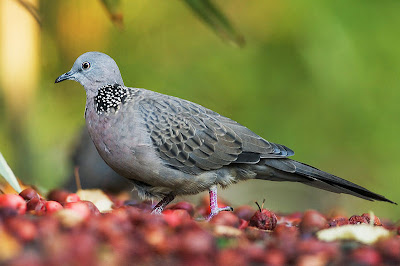Range
It is a common and widespread species in open woodland, farmland and habitation over a good deal of its natural range, and this successful bird has also been introduced to the U.S. in the Los Angeles, California area. other countries it has been introduced to include Singapore, the Philippines, northern Indonesia, Australia and New Zealand. In Australia, it was introduced in Melbourne in the 1860s and has since spread, often replacing native doves. In Australia, they are now found in streets, parks, gardens, agricultural areas and tropical scrubs, from Hobart, Tasmania to Cooktown, Queensland to Port Lincoln, South Australia. They can also be seen in Perth, Pemberton, Kalgoorlie and Esperance, in Western Australia. The species' range is expanding.
Characteristic
This species builds a stick nest in a tree and lays two white, glossy eggs. In southern Australia, they breed mostly from September to January, and in the north in Autumn. Its flight is quick, with the regular beats and an occasional sharp flick of the wings which are characteristic of pigeons in general.
Spotted Dove is a long-tailed, slim pigeon, ranging in length from 28 to 32 centimetres (11.2 to 12.8 inches). Its back, wings and tail are pale brown, heavily spotted with buff. In flight, it shows blackish flight feathers bordered on the inner edge with pale grey. Sexes are similar, but juveniles are duller than adults often lacking the patchy neckband when very immature. The head and underparts are pinkish, shading to pale grey on the face and lower belly. There is a black neck patch finely spotted with white. The legs are red.
The call is a low and gentle coo-coo-croo, with the emphasis on last note. The call occasionally is "coo-coo krrroo, krook!"
Behaviour
Spotted Doves eat grass seeds, insects, grains and other vegetation. They are fairly terrestrial, foraging on the ground in grasslands and cultivation. It breeds all year round with nests commonly found in trees, edge of buildings or even on the ground.

Like some other doves in this genus, they are not particularly gregarious, and are usually alone, or in pairs. It is tame but sudden noises flush them into flight. Flight patterns are similar to the Crested Pigeon. Upon landing, birds tilt their tail upwards. Males on display obtain a steep angle and circle down displaying their wings and tail by spreading them out.
New classification
This species has recently been placed into the genus Stigmatopelia by some authorities

